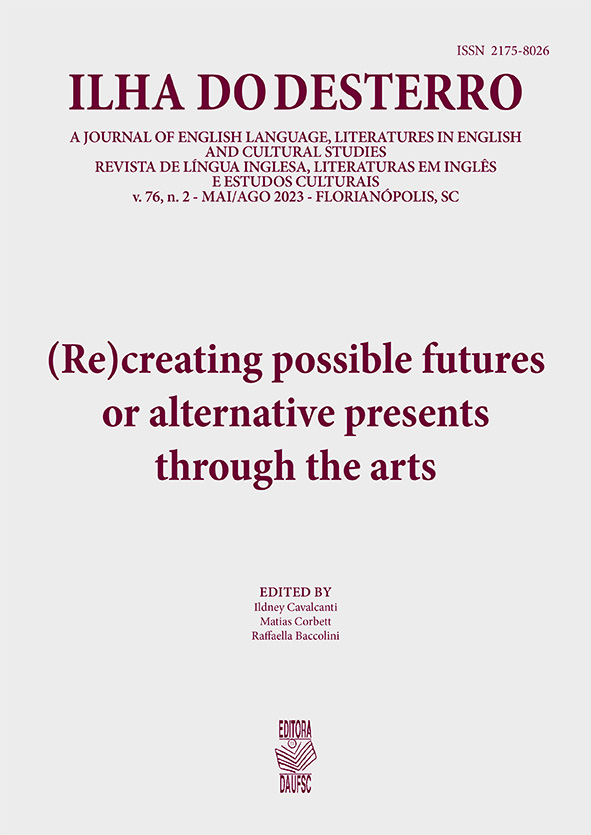Subversion and satire: apocalyptic futures in the world, the flesh and the devil and dr. Strangelove
DOI:
https://doi.org/10.5007/2175-8026.2023.e92578Palavras-chave:
Nuclear war, Post-apocalyptic fiction, Cold War, Disaster filmResumo
The objective of this article is to investigate Ranald MacDougall’s The World, the Flesh and the Devil (1959) and Stanley Kubrick’s Dr. Strangelove (1964) in their imaginations of disaster and apocalyptic futures. I aim to bring technical and narrative aspects of film in order to identify themes and speculative explorations of nuclear war and post-nuclear survival, emphasising political and social discussions that can be found in both films. Finding their singularities and similarities is part of my focus here, as these productions were made during the height of the nuclear scare of the Cold War in the United States and contain critical – and satirical – approaches to common themes found in apocalyptic/post-apocalyptic fiction of the time, each with their particular shifts.
Referências
Alder, Ken. “America’s Two Gadgets: Of Bombs and Polygraphs.” Isis, vol. 98, 2007, pp. 124-137.
Burch, Noël. Theory of Film Practice. Princeton UP, 1981.
Crowther, Bosley. “Movie Review: Dr. Strangelove: or How I Learned to Stop Worrying and Love the Bomb”. The New York Times, 31 Jan. 1964. Web. 20 Jan. 2023.
Crowther, Bosley. “Screen: ‘Man on Fire’; Crosby Has Difficult Role in State Film”. The New York Times. 23 Aug 1957. Web. 20 Jan. 2023.
Crowther, Bosley. “Screen: Radioactive City; ‘The World, the Flesh and the Devil’ Opens.” The New York Times, 1 May 1959. Web. 20 Jan. 2023.
Dr. Strangelove, or How I Learned to Stop Worrying and Love the Bomb. Directed by Stanley Kubrick. Performances by Peter Sellers, George C. Scott, Sterling Hayden, and Slim Pickens, Columbia Pictures, 1964.
Eisenstein, Sergei. Film Form: Essays in Film Theory. Translated by Jay Leyda, Harcourt Brace Jovanovich, 1949.
Kaufmann, Dave. “Film Review: ‘Dr. Strangelove: or How I Learned to Stop Worrying and Love the Bomb.’” Variety, 21 Jan. 1964. Web. 20 Jan. 2023.
Inside: ‘Dr. Strangelove, or How I Learned to Stop Worrying and Love the Bomb’. Directed by David Naylor. Columbia Tristar Home Entertainment, 2000.
Kermode, Frank. The Sense of an Ending: Studies in the Theory of Fiction. Oxford UP, 2000.
Metz, Christian. “A Grande Sintagmática do Filme Narrativo.” Análise Estrutural da Narrativa, edited by Aline dos Santos Carneiro et al., translated by Maria Zélia Barbosa Pinto, Editora Vozes, 2011, pp. 210-218.
Review: ‘The World, the Flesh and the Devil,’ by Variety staff. Variety. Written on 31 Dec 1958. Web. 20 Jan. 2023.
Seed, David. Under the Shadow: the Atomic Bomb and Cold War Narratives. The Kent State UP, 2013.
Smith, Judith E. Becoming Belafonte: Black artist, Public Radical. U of Texas P, 2016.
Sontag, Susan. “Imagination of Disaster.” Commentary, Oct. 1965, pp. 42-48.
Weart, Spencer R. Nuclear Fear: A History of Images. Harvard UP, 1988.
The World, the Flesh and the Devil. Directed by Ranald MacDougall. Performances by Harry Belafonte, Inger Stevens, and Mel Ferrer, Metro-Goldwyn-Mayer, 1959.
Xavier, Ismail. O Discurso Cinematográfico: a Opacidade e a Transparência. Paz e Terra, 2006.
Downloads
Publicado
Edição
Seção
Licença
Copyright (c) 2023 George Ayres Mousinho

Este trabalho está licenciado sob uma licença Creative Commons Attribution 4.0 International License.
A revista Ilha do Desterro publica artigos e resenhas inéditos, referentes as áreas de Inglês, Literaturas em Língua Inglesa e Estudos Culturais. Publica volumes mistos e/ou temáticos, com artigos e resenhas em inglês e português.
Autores mantém os direitos autorais e concedem à revista o direito de primeira publicação, com o trabalho simultaneamente licenciado sob a Licença Creative Commons Attribution que permite o compartilhamento do trabalho com reconhecimento da autoria e publicação inicial nesta revista.

This work is licensed under a Creative Commons Attribution 4.0 International License.



